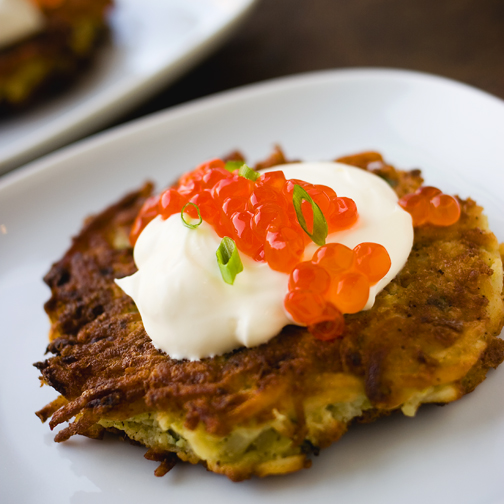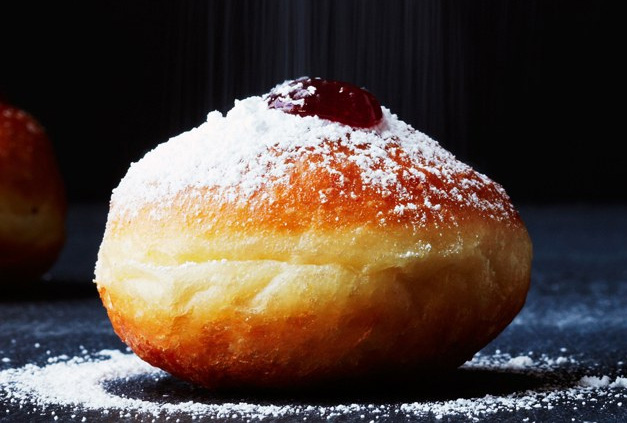Hanukkah: Food Traditions, Menus and Recipes
Category : Food Stories, Party Ideas, Recipes, Press Room |
Posted : Dec 15, 2016
The holiday of Hanukkah or Chanukah is a wonderful example of how historical memory and religious solemnity harmoniously interlace with the warmth and coziness of family traditions. This year the festival starts on December 24th (the 25th day of Kislev) and lasts for 8 days until January 1st (the 3rd day of Tevet).
The 8-day Chanukah celebrations take their roots in the 2nd century BCE when Jews led by Judas the Maccabee defeated the incredibly mighty army of Seleucids (Syrian Greeks) and drove them out of the Holy Land. The Hebrew word “Chanukah” literally means “dedication”, hence reminding about the rededication of the Holy Temple in Jerusalem to the service of one G-d after it was the shrine of Zeus, the Greek supreme god.
Most of Hanukkah traditions, which we know today, come from history of Jewish land and religion. What is more, they commemorate great events that have become important lessons taught to the whole world. At the same time, Hanukkah is a warm family holiday illuminated by soft light of menorah candles and ringing with joyful laughter of children who get their chocolate or real (or both chocolate and real) Hanukkah gelt. This is the time when families and friends gather to sing Maoz Tzur song and play dreidel. And, of course, as any other holiday, Hanukkah celebrations cannot go without a wide variety of traditional food.
Let us learn more about some interesting peculiarities of Hanukkah holiday dishes and discover a few nice recipes which will perfectly add to your exquisite menu.
The Festival of Lights and Why Olive Oil Is So Essential in Hanukkah Recipes
Indeed, olive oil is that ubiquitous ingredient which takes its rightful place in literally every Hanukkah recipe. However, sometimes it can be substituted with chicken or goose fat in the regions where olive oil is scarce and rather expensive.
Still, how can olive oil be connected with the fact that Hanukkah is also called the festival of lights? And why are most of Hanukkah dishes fried in olive oil? Let us find it all out!
Above you have read about the rededication of the Holy Temple, which is considered to be a great merit of Judas of Maccabee and his troops. So, after the temple was cleaned, they wanted to light the Menorah but there appeared to be no olive oil to do it. Suddenly, they saw a single cruse full of it. Judas knew that the olive oil in that cruse would be enough only for one day, but still he ordered to light the menorah candles. And the miracle happened! The candles burnt for eight days until new oil was prepared.
Since that time the Hanukkah holiday is known as the Lights or the Festival of Lights and is celebrated for eight days. Besides, until today the celebration is marked with kindling 9 candles of menorahs or hanukkiyas at homes. The ninth candle, called shamash, is fixed higher in between the other 8 candles and is usually used to light them all. So, on the first day the shamash and one more candle (the first one from the left) are kindled. On the second day the shamash is used to kindle two candles, then three, and so on.
As you have already guessed, olive oil has become a practically interchangeable ingredient of Hanukkah treats. So, now let us see what delectable things can be cooked with it.
Traditional Hanukkah Menu
Although it is said that today latkes are becoming less popular in Israel, still these nice pancakes, traditionally made of potato, remain one of the most noticeable dishes with which Hanukkah is associated. Today you can find plenty of recipes in which classic potato basis of latkes is substituted by other vegetables (such as beetroots or zucchinis), corn, cheese or even apples.
Here is an easy and original latkes recipe for you!

Ingredients:
- 2 1/2 lb baking potatoes; peel them and coarsely shred on a grater
- 1 medium onion; shred it on a box grater as well
- 2 large eggs, beaten
- 1/2 cup scallions, finely chopped
- 1/4 cup matzo meal
- 3 tbsp unsalted butter; melt it and cool slightly
- 2 tsp kosher salt
- 1/2 tsp black pepper
- 1/2 tsp baking powder
- olive oil, for frying
For Serving:
- applesauce
- sour cream or cream cheese
- smoked salmon
- salmon roe
Directions:
- Toss and squeeze dry the shredded potatoes and onion in a colander set over a large bowl. Let the medley drain for 2 to 3 minutes. Pour off the liquid in the bowl, leaving the paste at the bottom.
- In a bowl mix the paste with the eggs, scallions, matzo meal, butter, salt, pepper and baking powder.
- In a large skillet, heat olive oil until shimmering. Spoon approximately 1/4-cup mounds of the latke paste into the skillet about 2 in. apart and flatten slightly with a spatula. Fry the latkes over moderately high heat, turning once, until golden and crisp (5 to 7 minutes).
- Transfer the latkes to paper towels to drain, then transfer to a platter. Repeat to make the remaining latkes, adding more oil to the skillet when needed.
- Serve with applesauce, sour cream, smoked salmon and salmon roe.
The large variety of delicious Hanukkah treats also includes
- plenty of amazing appetizers, such as salmon crostini or potato and other pancakes served with sauces;
- or fried lamb chops with garlic, which, probably, do not need any further description – so perfect they are (you could also try some fried in breadcrumbs, garlic, rosemary and Parmesan cheese);
- beef briskets cooked in as many ways as there are chefs who have come up with numerous recipes (for example, BBQ briskets served with slaw, brisket stews and sandwiches, even your mac’n’cheese can be stuffed with briskets);
- sweet noodle kugels, let us say, with apples and caramel;
- or rugelach with marzipan, dark chocolate and orange (sounds like it must be something out of this world, doesn’t it?);
- and, naturally, no Hanukkah can ever go without sufganiyots or jelly doughnuts filled with every possible jam (the most difficult thing about this dessert is to choose the filling: strawberry and cherry preserves, raspberry and apricot jams or, maybe, some orange marmalade – just close your eyes and pick something up as there is hardly any other way to make the choice).

Marky’s Gourmet Store is glad to present the list of prime quality kosher products for you to enjoy your Hanukkah holiday time with delectable menus and high spirits! You are always welcome to check it for new offers!
Happy Hanukkah to You!













